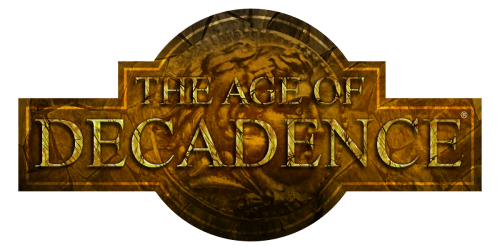The combat in The Age of Decadence is turn based, which means that each participant takes a turn and has a certain number of action points to use performing actions during each round. Once you enter combat, the fastest combatant will get to act first. When it's your turn, you will see a grid of squares surrounding your character. Take note of your hit points on the left and your action points on the right of your two weapon slots. On the far left is an information window that gives you more details about exactly what's going on during battle. Blue coloured squares are ones where you've enough action points to move during this turn, and if you hover the mouse over one the action point cost of moving to that square will pop up. Green coloured squares are those you can attack with your currently selected weapon (slot highlighted in yellow) and this is dependent on weapon reach and remaining action points. Move the mouse over a potential target on a green square and the name of the target, their tough state of health, and the likelihood of hitting them will pop up. Dark green means you can move or attack that square and red means that you can do neither.
Your character's Dexterity determines how many action points are available during each turn. Each action performed - swinging a sword, accessing your inventory, throwing a net, moving away, etc - has an associated AP cost. For example, a normal attack with a dagger (a fast weapon) takes 3AP, while a normal attack with a two handed hammer (a slow weapon) takes 6AP. Accessing your inventory during combat takes 4AP. There are two weapon slots, so either two one-handed weapons or a single two-handed weapon can be equipped at a time. The weapon's damage, range, and AP cost (modified by your stats, attack type, and ammo type) are displayed in the weapon slot. Right-click on the weapon slot to open a menu with the available attack options.
Attack Types
All weapons (except for crossbows) have fast, normal, and power attack options.
- Normal attacks (key: n) - standard attacks that have no modifiers.
- Fast attacks (key: f) - cause less damage, costs one AP less, but are more difficult to avoid. Generally most effective against fast, lightly armored opponents.
- Power attacks (key: p) - cause a lot more damage, costs an extra AP, but are easier to avoid. Generally most effective against slow, heavy armored opponents.
Aimed attacks all cost two extra AP's and have different to-hit penalties:
- Torso - normal damage range, -10% to hit, chance to find a weak spot in the armor (DR halved)
- Arms - fast damage range, -5% to hit, disarms on a successful hit
- Legs - fast damage range, -5% to hit, cripples (movement cost doubled) on a successful hit
- Head - power damage range, -15% to hit, but a chance of knocking the opponent out.
Special attacks:
- whirlwind (melee weapons)
- impale (spears only)
- flurry (daggers only)
- multishot (bows and throwing only)
- burst (repeater crossbow only)
The versality of crossbows comes from the different designs available: one-handed, double-shot, scoped, repeating with a magazine, etc. Unlike bows, crossbows have to be manually reloaded. You can right-click on a weapon to see the options available.
Critical Strikes
Critical strikes do more damage (20-40% extra damage tied to the size of your weapon) and can even lower one of your physical stats on a successful roll.
The likelihood of critical strikes is governed by the attackers critical strike skill compared with the defenders "vs critical" score, which is the higher of armour vsCritical, shield vsCritical, or 0.6 x CS-skill. Strikes to the head are compared to the higher of the helmet vsCritical or 0.6 x CS-skill. It's very important once your character is pitted against more skilful and experienced opponents that they have some defence against critical strikes, as many fights are all but decided by well placed or lucky blows. Even if you're built like a tank, getting stabbed in the liver puts a crimp in anyone's style and longevity.
Modifiers
Attack Modifiers
- Perception (Bonus and penalty)
- Weapon THC (Bonus)
- Shield and Helmet (Penalty)
- Attack types (Bonus and penalty)
- Nets (Penalty)
- Neurostymulant (Bonus)
- Berserk (Penalty)
- Arm Injury (Penalty)
Defense Modifiers
- Armor (Penalty - Dodge only)
- Nets (Penalty)
- Bolas (Penalty)
- Consecutive Defenses (Penalty)
- Leg Injury (Penalty - Dodge only)
- Knockout (Penalty)
- Mobility (Bonus or penalty - Dodge only)
Companions
There won't be any followers. However, there are situations where you are given help (town guards, faction members sticking up for you, hired bodyguards etc). You don't control such NPCs, their actions are scripted.
Looting
What you see is what you get. All enemies have inventories (to determine what they can use in combat), and once they are defeated or killed, you can take whatever they've had. Looting may bring in-game consequences, e.g. some fractions frown upon filthy looters.
Healing
Healing salve can't be applied in combat; additionally there will be doctors to heal PC for a fee in some locations.
